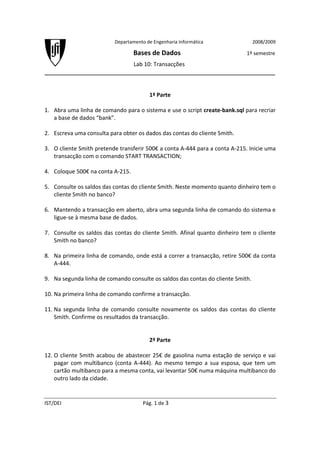
Bases de Dados Lab 10: Transações
- 1. Departamento de Engenharia Informática 2008/2009 Bases de Dados 1º semestre Lab 10: Transacções 1ª Parte 1. Abra uma linha de comando para o sistema e use o script create‐bank.sql para recriar a base de dados “bank”. 2. Escreva uma consulta para obter os dados das contas do cliente Smith. 3. O cliente Smith pretende transferir 500€ a conta A‐444 para a conta A‐215. Inicie uma transacção com o comando START TRANSACTION; 4. Coloque 500€ na conta A‐215. 5. Consulte os saldos das contas do cliente Smith. Neste momento quanto dinheiro tem o cliente Smith no banco? 6. Mantendo a transacção em aberto, abra uma segunda linha de comando do sistema e ligue‐se à mesma base de dados. 7. Consulte os saldos das contas do cliente Smith. Afinal quanto dinheiro tem o cliente Smith no banco? 8. Na primeira linha de comando, onde está a correr a transacção, retire 500€ da conta A‐444. 9. Na segunda linha de comando consulte os saldos das contas do cliente Smith. 10. Na primeira linha de comando confirme a transacção. 11. Na segunda linha de comando consulte novamente os saldos das contas do cliente Smith. Confirme os resultados da transacção. 2ª Parte 12. O cliente Smith acabou de abastecer 25€ de gasolina numa estação de serviço e vai pagar com multibanco (conta A‐444). Ao mesmo tempo a sua esposa, que tem um cartão multibanco para a mesma conta, vai levantar 50€ numa máquina multibanco do outro lado da cidade. IST/DEI Pág. 1 de 3
- 2. BD 13. Na primeira linha de comando, inicie uma transacção. 14. Na segunda linha de comando, inicie uma transacção. 15. Na primeira transacção retire 25€ da conta (abastecimento). 16. Na segunda transacção retire 50€ da conta (levantamento). O que se passa quando tenta fazer isto? Porquê? 17. A linha telefónica da estação de serviço está intermitente e a ligação cai. O pagamento que estava a ser feito tem de ser cancelado. Cancele essa transacção. 18. Ao mesmo tempo que faz a alínea 17, repare no que acontece na segunda linha de comando. Como explica este fenómeno? 19. Confirme a transacção de levantamento. 20. Consulte os saldos das contas do cliente Smith. 3ª Parte 21. No que se segue utilize apenas uma linha de comando. 22. Inicie uma transacção. 23. Altere a tabela depositor e remova todas as chaves estrangeiras. Use d depositor para ver que chaves estrangeiras existem. Use comandos na forma: ALTER TABLE (…) DROP CONSTRAINT (…) 24. Escreva um comando SQL para apagar da tabela account todas as contas do cliente Smith. Execute esse comando. 25. Escreva uma consulta para verificar se as contas do cliente Smith deixaram de existir. 26. Cancele a transacção. 27. Verifique que as contas do cliente Smith foram repostas. 28. Verifique que as chaves estrangeiras da tabela depositor foram repostas. IST/DEI Pág. 2 de 3
- 3. BD 4ª Parte 1. Considere o seguinte grafo de precedências que representa os conflitos existentes num escalonamento que envolve cinco transacções. O escalonamento é serializável? Justifique. 2. Considere as seguintes transacções: Inicialmente a base de dados tem A = 0 e B = 0. Para que a base de dados se mantenha consistente é necessário que A = 0 ou B = 0. (a) Mostre que os escalonamentos em série destas duas transacções mantêm a consistência da base de dados. (b) Apresente um exemplo de um escalonamento concorrente de T1 e T2 que não seja serializável. Explique porquê. (c) Existe algum escalonamento concorrente de T1 e T2 que seja serializável? Justifique. (d) Adicione instruções de lock‐S(), lock‐X() e unlock() às duas transacções de modo a que obedeçam ao protocolo em duas fases. (e) Com o resultado da alínea (d) dê um exemplo de um escalonamento concorrente que resulte em deadlock. (f) Adicione instruções de lock() e unlock() às duas transacções de modo a que obedeçam a um protocolo em árvore, em que a árvore é simplesmente A → B. (g) Com o resultado da alínea (f) são possíveis deadlocks? Justifique. IST/DEI Pág. 3 de 3
